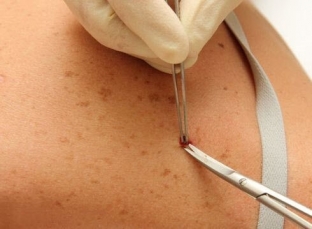Birthmark (nevus, mole) – This is a pigmented formation on the skin, which can have a different shape, size and color. A birthmark, despite its name, can be either congenital or acquired in origin. The growth, which is most often brown, black, red, or purple, can range in size from a poppy seed to several centimeters in diameter. In shape, the mole in most cases looks like a flattened smooth formation that slightly rises above the skin. In other cases, a birthmark rises strongly above the surface of the skin and may even interfere with a person when dressing or putting on shoes. The diagnosis of birthmarks helps to find out the cause of the appearance of education.
Causes and factors of birthmark formation
In addition to exposure to sunlight, the appearance of moles can be influenced by other pathological factors. Hereditary predisposition to moles is a very powerful risk factor, which often leads to the appearance of pigmented formations in different parts of the body.
In addition, it is necessary to note the role of hormonal fluctuations that can occur during stress, various diseases, after childbirth or surgical interventions, notes estet-portal.com. Against the background of these same hormonal changes, new birthmarks can appear as well as old ones disappear.
Radiation or X-rays, viral infection and various traumatic injuries can also cause the pigment melanin to move from the deep layers of the skin to the epidermis, which is located superficially, which causes the appearance of birthmarks.
Vascular nevi are exclusively of hereditary origin. They cannot change their size, shape or localization under the influence of any external factors, except for a surgical operation.
Thus, the causes of birthmarks are as follows:
- sunlight action;
- hereditary predisposition;
- hormonal imbalances;
- injury, viral infection;
- X-ray and radiation radiation.

Basic methods in the diagnosis of birthmarks
It would seem that considering the presence of a birthmark on one of the skin areas is not difficult even for a person who does not have a medical education.
In fact, the main problem in diagnosing birthmarks is not to state the fact of the presence of this formation, but to determine the cause of its appearance in order to develop further treatment tactics.
As a rule, the algorithm for diagnosing birthmarks is as follows:
- Inspection. Most often, at this stage, the patient is examined by a dermatologist. Inspection is preferably carried out in a well-lit room. Before this procedure, the birthmark must not be treated with anything.
 Dermatoscopy. This simple instrumental study consists in examining a pathological formation under a magnifying glass. In some cases, even a small increase helps the doctor to see some pathological changes on the surface of the spot, which can be used to suggest, for example, the malignant nature of the formation.
Dermatoscopy. This simple instrumental study consists in examining a pathological formation under a magnifying glass. In some cases, even a small increase helps the doctor to see some pathological changes on the surface of the spot, which can be used to suggest, for example, the malignant nature of the formation.- Fingerprints. A glass slide is applied to the surface of the birthmark, which is then carefully examined under a microscope. This diagnostic method is especially effective if there are erosions or ulcerations on the surface of the spot.
 Biopsy. This procedure consists in the excision of a tissue fragment for subsequent histological examination. Such a study makes it possible to make an accurate diagnosis, but it requires operating conditions, which very often becomes the reason for refusing such a diagnosis.
Biopsy. This procedure consists in the excision of a tissue fragment for subsequent histological examination. Such a study makes it possible to make an accurate diagnosis, but it requires operating conditions, which very often becomes the reason for refusing such a diagnosis.
It should be noted that even with the slightest suspicion of the malignant nature of the formation, the diagnosis of birthmarks should be carried out in full. Find out about the treatment of birthmarks in our next article.







Add a comment